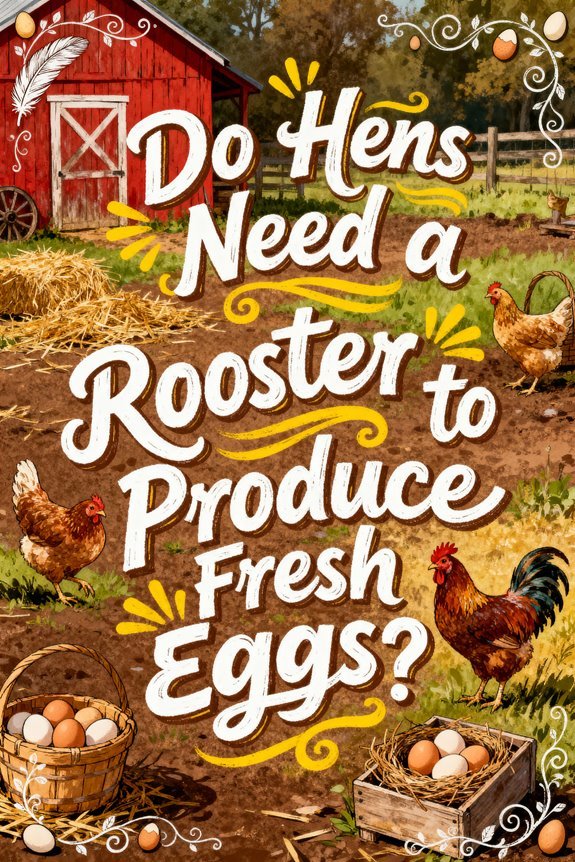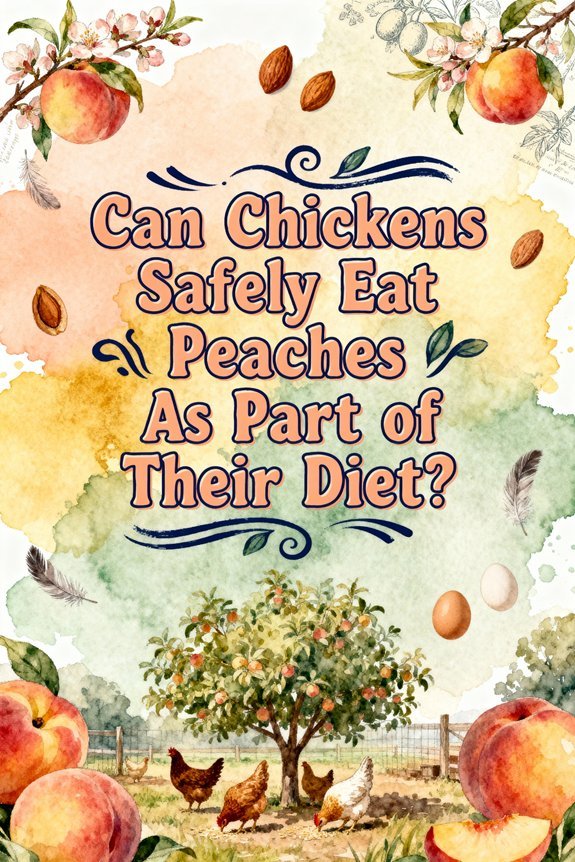Can Chickens Safely Eat Mango as a Treat?
Yes, you can safely feed mango to your chickens as an occasional treat. The fruit provides essential vitamins A, C, and B complex, along with beneficial antioxidants and minerals that support immune health and digestion. You’ll need to remove the pit and peel completely, then cut the flesh into small pieces. Limit treats to 10% of their daily diet, serving 1-2 tablespoons per chicken once or twice weekly. Understanding proper preparation and portion control guarantees your flock receives maximum nutritional benefits.
Benefits of Feeding Mango to Your Chickens
While many poultry owners focus on conventional feed, mangoes offer significant nutritional benefits for chickens that shouldn’t be overlooked. This tropical fruit provides essential vitamins and minerals, including vitamin A, C, and B complex, which deliver substantial nutritional advantages for your flock’s overall health. Like safe berry varieties, mangoes can be a nutritious treat when offered in moderation.
You’ll find that mangoes support immune enhancement through their high antioxidant content, particularly mangiferin, which protects your chickens’ cells from oxidative damage. The fruit’s dietary fiber promotes digestive health, while its water content aids hydration. The fruit’s digestive enzymes help break down complex carbohydrates for better nutrient absorption. Research shows that mango components can improve feed efficiency and growth performance in your birds. Additionally, the fruit’s mineral content, including magnesium, potassium, and zinc, supports muscle development, bone strength, and ideal egg production in your laying hens. With proper nutrition like mangoes supplementing their diet, heritage breed chickens can live up to 15 years under excellent care conditions.
Safety Risks and Precautions
Although mangoes provide nutritional benefits for chickens, several safety risks require careful consideration before incorporating this fruit into your flock’s diet. The high sugar content can lead to obesity, diabetes, and metabolic disorders if you don’t limit treats to 10% of daily intake. Watch for signs of sugar overload, including digestive upset and disrupted nutrient absorption.
The fruit’s acidic nature can cause crop irritation and stomach inflammation, particularly when fed in large quantities. You’ll need to remove seeds and pits completely, as they contain toxic compounds that can cause gastrointestinal distress and seizures. The toxic mango leaves must also be kept away from chickens to prevent dangerous allergic reactions. Additionally, mango peels may trigger allergic reactions in sensitive birds and often harbor pesticide residues. Since healthy hens typically lay one egg per day, excessive sugar intake could disrupt their natural laying patterns. Consider offering flock blocks made with wholesome grains and seeds as a healthier alternative to fresh mango. Always wash mangoes thoroughly, serve in small pieces, and remove uneaten portions promptly to maintain proper hygiene.
How to Properly Serve Mango to Chickens
Before introducing mangoes to your chickens, proper preparation and serving techniques are essential for maximizing nutritional benefits while minimizing health risks.
Select ripe, unblemished mangoes and wash them thoroughly under running water. Remove the skin and pit completely, then cut the flesh into small, beak-sized pieces. You’ll want to serve the mango raw in a clean, shallow dish placed in a shaded area of the coop or run. While mango can be a nutritious alternative fruit option that aligns with chicken dietary preferences, limit treats to 10% of their daily intake. Serve once or twice weekly, and remove uneaten pieces within a few hours. Consider combining mango with regular feed to encourage consumption while maintaining proper nutritional balance. The juicy fruit provides essential vitamins and minerals that support immunity, heart health, and bone strength.
Which Parts of the Mango Are Safe
Understanding which parts of a mango are safe for chickens is essential for preventing potential health issues while maximizing nutritional benefits. The flesh and juicy seed covering are completely safe and provide valuable vitamins and minerals. While mango leaf safety isn’t a significant concern, chickens rarely show interest in consuming them. Regarding mango skin edibility, the peel is technically safe but may contain pesticide residues and urushiol, which can trigger allergic reactions.
You’ll need to avoid feeding the pit or stone, as it contains toxic cyanogenic compounds that can harm your chickens. Remove all seeds before serving, and wash the fruit thoroughly if you’re including the peel. For ideal safety, stick primarily to the flesh, which offers the best nutritional value without risks. The flesh provides chickens with essential B vitamins that support their metabolic functions. Since chickens are social animals, it’s best to provide enough mango pieces for the entire flock to enjoy together.
Best Practices for Portion Control
Proper portion control plays an essential role in maintaining your chickens’ health when feeding mango treats. You’ll want to limit portion sizes to 1-2 tablespoons of diced mango per chicken per serving, guaranteeing you don’t exceed treat frequency of 1-2 times weekly. Use a measuring spoon to maintain consistency, and offer the fruit during active periods to promote proper digestion. The high vitamin C content in mangos makes them an excellent nutritional supplement when portioned correctly.
Monitor your flock’s response to the portions you’re providing. If you notice signs of digestive upset, reduce the amount accordingly. You’ll need to complement these treats with regular feed and make sure fresh water is available. Remember that mango’s high sugar content requires moderation – excessive portions can disrupt gut flora and lead to obesity. Store unused portions properly and remove uneaten fruit after several hours.
Preparing Store-Bought Mangoes for Your Flock
Safe preparation of store-bought mangoes requires multiple steps to protect your flock from harmful pesticides and additives. Begin with thorough mango washing techniques by running each fruit under cool water while gently scrubbing the surface. If you’re uncertain about pesticide removal methods’ effectiveness, it’s best to remove the skin entirely. Much like with cooked beans, mangoes must be properly prepared to ensure safety for your chickens. Most chicken breeds have three front toes that help them maintain balance while eating treats. Similar to brown rice feeding, mangoes should only make up a small portion of your chickens’ overall diet.
Cut the cleaned, peeled mango into small, bite-sized pieces to prevent choking hazards. Don’t include the pit or seeds in your chickens’ portions. Avoid any prepared mango products containing salt, sugar, spices, or other additives – these can harm your birds. While cooking mango is safe, it reduces nutritional benefits, so serve it raw. Remember to discard any spoiled sections and store unused portions in a cool, dry place to maintain freshness.



